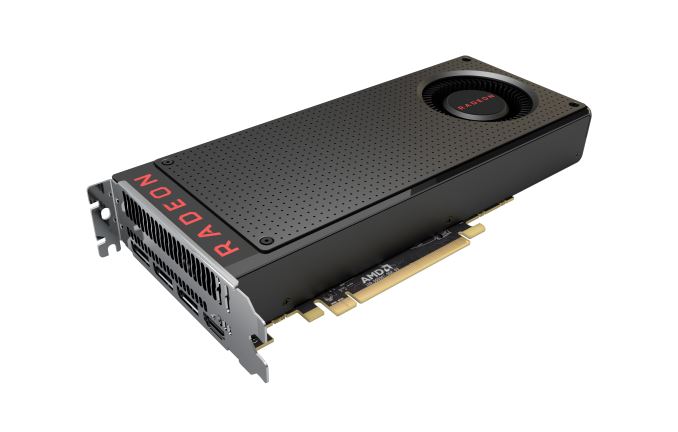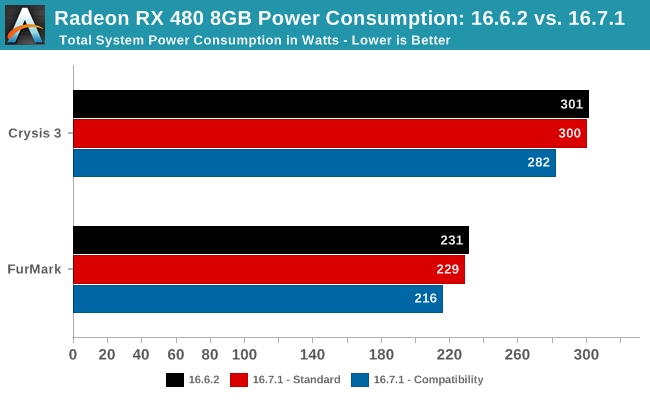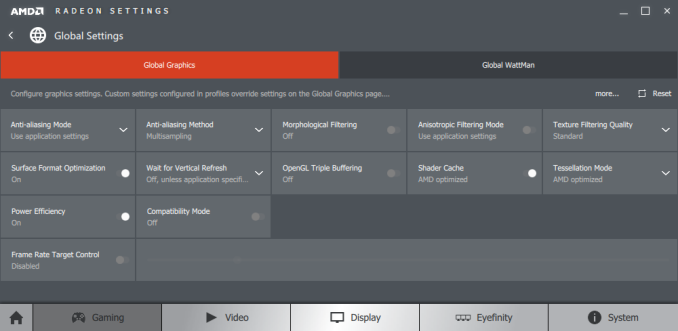AMD Posts Radeon 16.7.1 Drivers, Fixes RX 480 Power Consumption Issues
by Ryan Smith on July 7, 2016 6:50 PM EST
In what’s hopefully the final chapter on AMD’s saga over the last week with the Radeon RX 480’s power consumption, AMD has posted the previously promised 16.7.1 driver set on their website.
As a reminder, 16.7.1 is being released first and foremost to address RX 480’s power consumption issues, in which reviewers found that it was drawing too much power from the PCIe graphics (PEG) slot, and that the total power consumption of the card was at times exceeding 150W, which is the technical limit for a card with a 6-pin power connector. Of the two issues, PEG power consumption is arguably the greater of the two, as the external power connectors are far more forgiving.
To that end, 16.7.1 rolls out a two tier solution to the problem.
- Shift some of the power load off of the PCIe Graphics (PEG) slot connector in order to bring PEG slot power consumption within the PCIe spec. This doesn’t reduce total power consumption and performance is unaffected; power delivery is merely shifted. Based on earlier data this will put the 6-pin connector further over spec, but the vast majority of PSUs are very tolerant of this going out of spec.
- Because total power consumption of RX 480 can still exceed 150W – and as a result also exceed the limits for the 6-pin connector – AMD has also implemented an optional a “compatibility” toggle that reduces the total power consumption of the card. This is to better ensure that both the PEG slot and 6-pin power connector stay below their respective limits. Since the RX 480 is already throttling at times due to power limits, this does hurt performance (more on that below), but it's also the most standards-compliant solution.
Along with the power changes, the driver also incorporates some previously scheduled bug fixes and performance improvements. This includes fixing GTA V stuttering, and small performance boosts for a limited number of games that AMD states should improve performance by up to 3%.
Finally, the 16.7.1 driver can be found on AMD’s website. Note that the driver itself is not WHQL certified, but given AMD’s rush to get it out ASAP, I don’t imagine they were interested in waiting for WHQL certification to come back before releasing them.
Diving into matters then, PC Perspective has already taken a look at the new driver and done individual power rail measurements, finding that AMD’s fixes work more-or-less as advertised. They have found some edge cases where the card is still drawing a watt or two more power from the PEG slot than the specification allows, though at this point we’re arguing over inches. It should be noted however that even in compatibility mode, PC Perspective is still finding that power consumption is technically exceeding 75W on the 6-pin connector, though like the PEG slot by notably less than when not using compatibility mode.
Meanwhile to look at the performance impact of the new driver, I quickly ran our RX 480 through a selection of games at 2560x1440, both with and without compatibility mode.

In standard mode where power consumption isn’t curtailed, performance is essentially unchanged outside of Tomb Raider, which is one of the games targeted for optimization. Essentially this proves that there’s no performance impact from merely shifting power consumption off of the PEG slot to the 6-pin power connector.
Meanwhile in compatibility mode, there is a very small performance hit, though it varies with the game. Compared to standard mode, we’re looking at no more than a 1fps performance drop (~3%), with some games losing only a fraction of a frame per second. That there is a performance drop is consistent – so compatibility mode isn’t free – but overall the performance change is within the +/- 2% margin of error for these benchmarks.

Finally, when it comes to power consumption, measurements at the wall back up our earlier findings. In standard mode, power consumption at the wall bobbles by a couple of watts compared to the 16.6.2 drivers. With compatibility mode on, we see power consumption drop by 18W under Crysis 3, and 13W under FurMark. The average GPU clockspeed in both cases is similarly reduced, with Crysis 3 shaving off around 50MHz.
Anyhow, we’ll have a bit more on the subject in next week’s full Radeon RX 480 review. But in the meantime it looks like AMD has been able to get a handle on their power problems and largely rectify them within the span of a week, making for a fairly quick recovery on the RX 480’s launch fumble.











105 Comments
View All Comments
nick85er - Friday, July 8, 2016 - link
perhaps ultra 3160p is the only way to activate the self-destruct mode we've been hearing so much about?i demand a retest.
nick85er - Friday, July 8, 2016 - link
dammit, was laughing too hard.. meant 2160pSunnyNW - Thursday, July 7, 2016 - link
I had read that the implementation of the power distribution on the card results in it pulling power from the PCIe slot for the memory. If this is indeed the case, then is there still going to be over-draw from the slot in the event of a memory overclock. I myself am not too worried but would it still present something similar to the initial problem for older boards?prisonerX - Thursday, July 7, 2016 - link
It's not the case. There is a power phase controller which can be configured to draw from each source as required, then some of the phases are used for memory and some for the GPU. The controller has likely been programmed to draw a max of 75w from the slot.extide - Thursday, July 7, 2016 - link
There are 6+1 phases. 6 for the GPU, and 1 for the memory. Three of the 6 GPU phases are hard-wired to the PCIe slot, and the other 3 to the PEG connector. They can't switch where each phase draws power from, but they can vary the duty cycle of each of the phases individually, so they can basically lower the duty cycle on the phases connected to the slot, and raise them on the other 3. The card's power supply is already pretty overbuilt as it is, o making 3 of the phases work harder is not a concern, I bet they could run the whole GPU off 3 or 4 phases if they wanted to.According to the diagram on PCPer the memory phase is wired to the PEG connector, not the PCIe slot, but in any case it cannot be changed in software at all, it would require a new PCB layout to change that.
D. Lister - Thursday, July 7, 2016 - link
Good job. Now in a couple of days when the 1060 is released, we'll have a proper bout. No-shows are so boring.barleyguy - Thursday, July 7, 2016 - link
The 1060 won't be released in a couple of days. The GP106 isn't ready, and the GP104 is supply constrained by yields. They might make enough for reviewers just for a marketing bullet, but they won't be in the hands of customers. I'd bet a month at least, maybe longer.HighTech4US - Thursday, July 7, 2016 - link
How are those rose colored glasses working out for you?silverblue - Friday, July 8, 2016 - link
The rumour (i.e. SA) is that the 1060 will use a GP104 with fused-off sections as the GP106 isn't ready yet. Charlie isn't always correct (I think he covers himself with the name of his website, which should be called SemiAvailable in all fairness) but it's not long before we find out what GPU is actually on the card. If the GP104 is indeed present, it's a failed part which they've salvaged, however these usually use a bit more power than a true die created for the task at hand, which could be why the 1060's TDP is not lower - it's still two-thirds that of the 1080. It's not as if its clock speeds are any higher than its bigger brothers at this time.I doubt the 1060 will be delayed, and I imagine it'll have the GP106 after all; 11 days to find out.
Michael Bay - Friday, July 8, 2016 - link
>demerjan>source
>on anything nV